Hyperbolic Crochet Coral Reef, x2
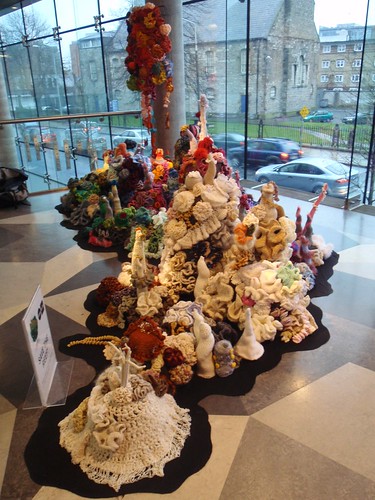
The Hyperbolic Crochet Coral Reef exhibition at the Science Gallery will end this Friday 11th June, so if you haven't already gone to see it, I recommend you high-tail it there in what remains of this week. You'll see a beautiful and fascinating display of a little known form of geometry made manifest in coral-like models fashioned from fibres of many kinds, which simultaneously illustrate the unfolding ecological peril of coral reefs worldwide. Hopefully that description with its minimum of hyperbole is enough to entice you to experience it directly – be reassured that it makes much more sense when you see and touch it yourself.
Hyperbolic crochet, in concept and reality, has been fascinating me for the last few months. I first heard about it from some crafter friends, when it sounded quite fantastical, and have since read up a little about its geometry and origins. I even went so far as to purchase my very own crochet hook and actually create a few tiny pieces, at first with informal and friendly instruction at a preparatory workshop for the exhibition, and later was almost unable to stop myself continuing to crochet at home, on the Luas and on the DART. Cue unending awful puns about getting hooked – you'll have to add in your own witticisms, because between the speakers at the exhibition launch and reading a couple of articles about hyperbolic crochet, I don't think I could bear to make yet another crochet-themed play on words. On the other hand, I can't say I've completely gotten my head around all the mathematical concepts, but it is scientifically fascinating, and very beautiful.
As far as I understand it, hyperbolic space refers to a third type of geometry, after Euclidean geometry (essentially geometry on a plane, the type you're subjected to at school about triangles, circles, squares and all the rest) and spherical geometry, the type that applies on spheres, which you could imagine might be important for us as the Earth is close to spherical. In Euclidean geometry, parallel lines never meet. In this familiar type of geometry, if you have a straight line and a point outside that line, a second straight line can be drawn through that point which will never intersect with the first line. In spherical geometry, on the other hand, if you have a straight line and a point outside that line, any straight line drawn through that point will eventually intersect with the first line. So in Euclidean geometry there is one parallel line, in spherical geometry there are none. So far, so familiar. But there are more options than zero and one – already a point worth remembering in our computer-obsessed age. In hyperbolic geometry, there are infinitely many straight lines that can be drawn through the point which will never intersect with the first straight line. This creates not craziness, but a third consistent form of geometry, which was called hyperbolic precisely because of its infinite 'exuberant excess'.
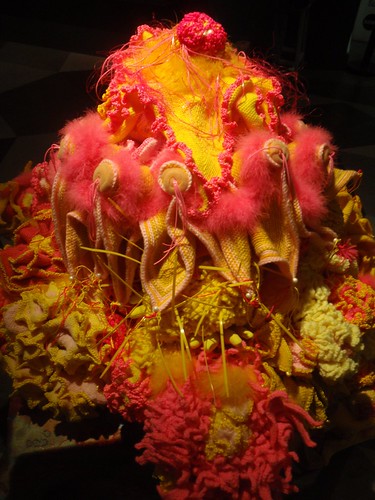
Why is this interesting and how does it relate to crochet? Well, for a long time, mathematicians tried to prove that such hyperbolic geometry was impossible – it seemed absurd, and possibly contradictory. Eventually in the 19th century mathematicians had to conclude that it was possible. But it is difficult for us to get our heads around, difficult to depict, and difficult to model. Henry Poincare drew diagrams of it, and MC Escher tried to depict it with the famous drawings of his Circle Limit series – discs of symmetrical fish chasing each other's tails, and of demons and angels, their wings spread wide. In the 1970s William Thurston made a paper model of hyperbolic space, but it was fragile, difficult to construct and hard to handle.
In 1997 Dr Daina Taimina, a Latvian mathematician, finally made the first robust and useable physical model of hyperbolic space, and she made it out of crochet. Is it coincidence that Dr Taimina succeeded where so many male mathematicians had failed? With crochet, adding stitches in a regular way creates forms which physically demonstrate the idea of multiple straight parallel lines that do not meet. These forms really need to be seen, and touched, to be understood, and that was one of Taimina's goals – to allow students to truly grasp this form of geometry. The resulting forms are both mathematically beautiful and tangibly useful. Or tangibly beautiful and mathematically useful, to put it another way.
Why crochet? It's a system where stitches can be easily added, and it quickly begins to exhibit the 'ruffled' crenellated shape of hyperbolic forms. It is also easier to handle than knitting, where all the stitches in a row are held on a needle at the same time, making it cumbersome and heavyto handle as the number of stitches increases, which is, of course, bound to happen with hyperbolic creations. In crochet, only one stitch is held on the hook at a time, so increasingly large forms are much easier to handle. When Taimina spoke at the Science Gallery last week, she commented that the first row of stitches in the first model she made was only 20cm long, which would have taken a couple of minutes to crochet (even for a beginner like me), but increasing every third stitch meant that the last row just eight or so rows later was so long that it took an hour and a half to complete.
How did a mathematical model become a travelling hyperbolic crochet coral reef? It is immediately noticeable that the models resemble coral, mainly because coral itself naturally exhibits an imperfect form of hyperbolic geometry. Kelp, 'lacy' lettuce and the tiny marine animals nudibranches (pronounced nude-ee-brangs) are other naturally occurring examples –though mathematicians until recently had failed to notice this, or perhaps they hadn't consulted with their biologist colleagues. Placing a few of Taimina's mathematical models next to each other, the similarity to a coral reef almost leaps out. As these models became more well-known through Taimina's work, academic papers and occasional exhibitions, they caught the interest of Margaret and Christine Wertheim, Australian sisters with an interest in both scientific communication and in handicraft. They began crafting some, both mathematically regular and in more natural irregular adaptations. As Christine Wertheim put it at a workshop prior to the exhibition, Margaret uttered the words 'why don't we make a crochet coral reef' and what became a five year global collaborative project was born. The sisters thought at most a dozen other crafters might be interested in participating; instead thousands of people took up their hooks and reefs have been made in Australia, the U.S.A, Latvia, England, Japan and now Ireland.
In advance of the visit of the hyperbolic crochet coral reef to the Science Gallery, a call went out for crafters to create an Irish “people's reef” as the collaborative community reef-making project is known. People all over the country contributed pieces individually, at knitting and crochet groups and through workshops. It was at one of these workshops that I picked up a crochet hook for the first time in 20 years and, after moments of helpful tutelage by some only slightly more experienced and less confused co-crocheters, created my first piece of hyperbolic crochet. This pride and joy is pictured below:
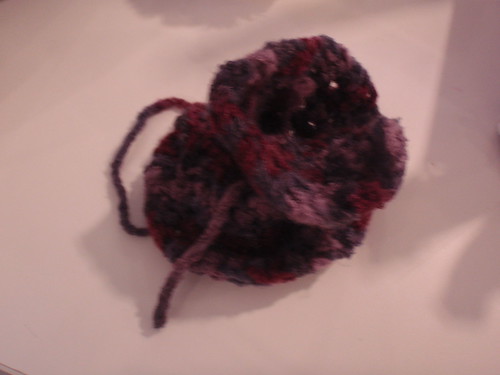
I say only slightly less confused as the first person I asked knew how to create the first row, or 'chain', which we both managed, but then found we'd no idea how to do the second, more involved row, which is where the 'real' crocheting starts. With the help of another person who understood the second row mystery we were all soon crocheting away, not very mathematically but with gusto. Some beginners nervously stuck to creating incredibly long chains, twirling on for metres, like a lengthy but miniature scarf. For me, it was heartening and inspiring to collaborate with people who were welcoming and enthusiastic to total beginners, and to feel part of a community of creative collaboration.
It was also strange but quite pleasant to be in the entirely female company of the workshop, which appeared automatic and unremarkable to most of its participants but for me was unusual. The workshop itself was open to all, yet no men had chosen to attend. Some people there were experienced knitters and crocheters from groups who regularly got together to craft, and it was clear that this was often, and perhaps always for them, a solely female activity. There was a familiarity and level of comfort with an entirely female setting that was perhaps noticeable to me precisely because of my relative lack of familiarity with it. The Wertheim sisters said that of over 3000 people who have contributed to the reef, only three have been men. My sense that there was an underlying assumption of female-only involvement, and the references by the Wertheims to crochet as one of what they called the 'feminine handicrafts', seemed to me to have contributed to the overall lack of male involvement. The process did not exclude men, nor did it invite them, and I don't think it should necessarily have done either. It's more an observation about what was said and not said, who was present and absent, what was explicit and what was assumed, and about which I haven't yet drawn any conclusions, but found quite interesting.
Having joined in the workshop reefer madness (ba dum tish, just couldn't resist a second pun), like dozens of other people around Ireland I made some more pieces and contributed them to the reef. Here they are:

The Irish people's reef went on display on 20th March with the launch of Hyperbolic Crochet Coral Reef: A Woolly Wonder at Science Gallery. The exhibition combined explorations of the scientific and mathematical topic of hyperbolic space with the ecological topic of coral reefs, as well as being a celebration of handicraft and the art of crochet.
The exhibition featured the Latvian people's reef, partially constructed by school children and appearing outside Latvia for the first time. Some pieces like the one below were hung next to the Irish reef.
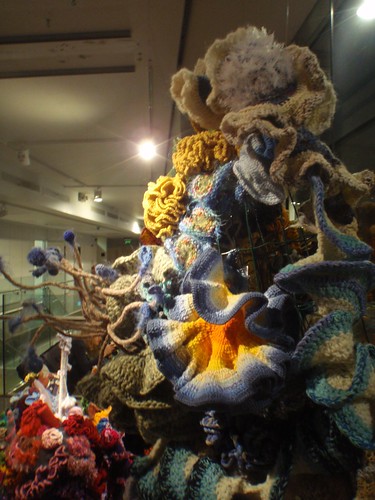
The exhibition featured collections that travel as part of the international touring exhibition, such as the Ladies' Silurian Atoll and the White Spire Grove, pictured below.
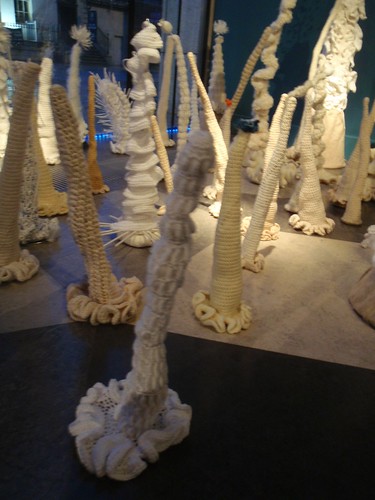
The Beautiful Holy Jewel section had some stunning bead work and tiny pieces, and there were also some quite lovely wire and bead pieces in the Irish reef.
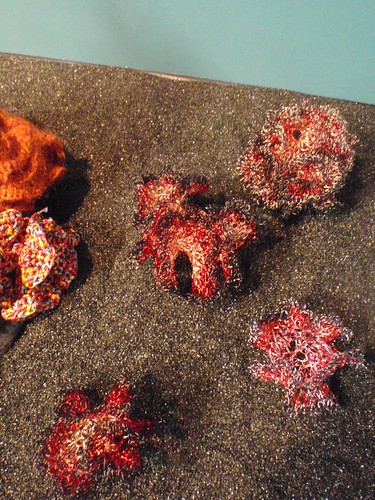
There was also the Bleached Bone Reef, an illustration of how coral goes white due to rising sea temperatures, a change that indicates the coral is struggling to survive or even dying. I've seen this phenomenon on real reefs and it is tragic.
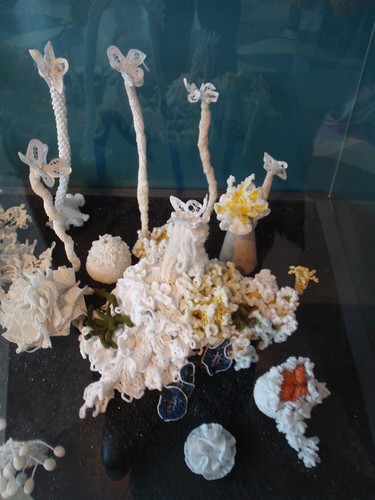
There were also plenty of crochet pieces you could pick up or plunge your hands into. Enjoyable and educational.
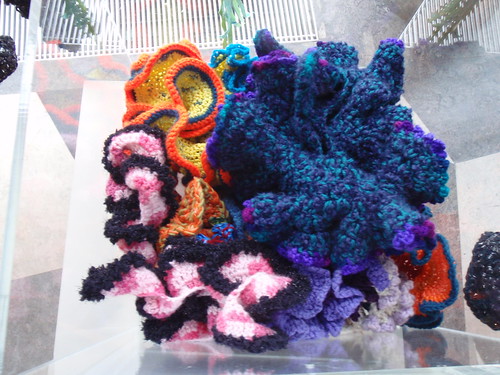
And some of my pieces even appeared in the reef - can you spot it?

The lovely undulating structures of the people's reefs appeared above the toxic reef - imaginative and strangely attractive structures made of plastic and other rubbish, which highlighted the problem of massive accumulation of plastic debris in the Earth's oceans. I was struck by the curators' point that this plastic rubbish eventually breaks down into plastic sand which will sink to the ocean floor and form a permanent plastic layer in the planet's geological strata, making the idea of 'disposable' plastic even more of an oxymoron.

The above including a piece by the wonderful An Snag Breac
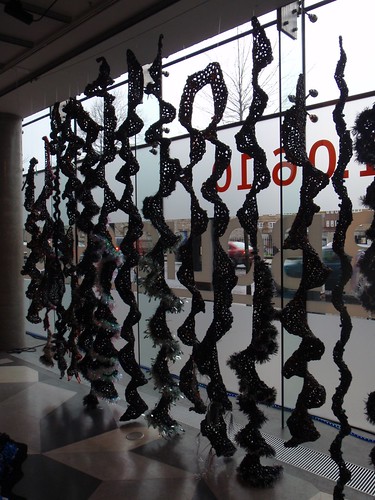
The only less than impressive aspect to the exhibition was that there wasn't entirely enough effort made by Science Gallery to inform and credit the dozens of contributors. For such a community-based project, such follow-through and communication is essential. Some contributors did not receive invites to the exhibition's launch, despite requests and assurances, and some contributors' names (including my own, as someone unfortunately pointed out to me) were left off the list of Irish contributors displayed beside the reef. There were over 80 crocheters around Ireland who contributed to the community reef. An additional sign with more names did appear in the last two weeks of the exhibition. More seriously, some submitted pieces were not displayed, and contributors hadn't been informed that this could happen nor did any signs indicate that not all the work was in the exhibit. Apparently all the Irish pieces will travel with the exhibition and they hope to exhibit them elsewhere if there is more space. Appropriately recognising the contribution of community members to collaborative art projects is an important issue, and my goal in airing these issues here is to improve that communication in future, not to take away from what was a beautiful and interesting exhibition of little-explored and significant topics. Taimina herself talked about how she started to really publicise her work in this area because her husband, also a mathematician, kept getting contacted by people who presumed it was him working on hyperbolic crochet. As she jokingly put it, “I understand that women don't get any mathematics credit, but at least get the crochet credit!”
Returning to the origins of hyperbolic crochet as a mathematical model, the Maths Chapel at the exhibition featured explanations of the nature of hyperbolic geometry and some of Taimina's mathematically exact models which you could handle, with sewn on lines indicating where to fold to demonstrate various features of hyperbolic geometry. Two original Escher woodcuts of the Circle Limit series were also on display. At the launch the Wertheims commented on how happy they were that the exhibition was appearing for the first time in a science museum, instead of in its usual venue of an art gallery, as they had always intended it to be a science communications tool.
It was a real gift that Science Gallery hosted Daina Taimina on 2nd June, towards the end of the Hyperbolic Crochet Coral Reef's exhibition. She talked about how once she drew out what happens in hyperbolic geometry – one linked to two, two linked to four, four become eight – it was clearly a crochet pattern. She also pointed out that because it is impossible to describe the surface of hyperbolic shapes using equations, the whole hyperbolic plane cannot be computer animated. Another point worth remembering when ones and zeroes seem to be shaping every part of modern life.
Taimina observed that people often want to find a 'practical' use for mathematical ideas – thus the excitement about what happens when you fold a hyperbolic form in certain ways, fitting edges against each other – voila, “hyperbolic pants”:
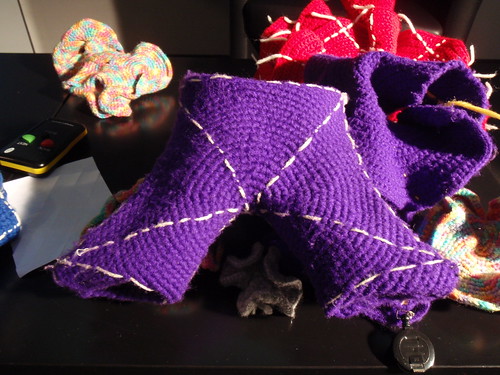
What I found more exciting about this is that if the holes at each end were joined together (which merely requires a fourth dimension) what seems like a kind of wormhole would be created. Finding that hard to comprehend? Buy Taimina's book Crocheting Adventures with Hyperbolic Planes and have some fun understanding it. And you can take pleasure in the knowledge that the book won the 2009 Diagram Prize for Oddest Title of the Year. You'll also be contributing to the good cause of increasing Taimina's wool stash – as it is she says she makes money from maths using the model “teach calculus so I can buy some more expensive yarn”.
I was certainly excited and inspired by Taimina's talk, notwithstanding the warning she quoted about the dangers of geometry:

Hyperbolic space, handicraft art, coral ecology and community collaboration – the Hyperbolic Crochet Coral Reef expanded my understanding and my active participation in many ways. Thanks for making this experience possible go to Dr Daina Taimina, the Wertheim sisters, Science Gallery, the friends who introduced me to the concept, everyone who showed me how at the workshop and all the crochet crafters who created the Irish reef together. And if you haven't seen the Hyperbolic Crochet Coral Reef yet, go right now!
More photos of the Hyperbolic Crochet Coral Reef
1 Comments:
wonderfull... Ilove your coral reef :) http://byhandkinkin.blogspot.com/2010/06/out-from-deep-1.html
Post a Comment
<< Home